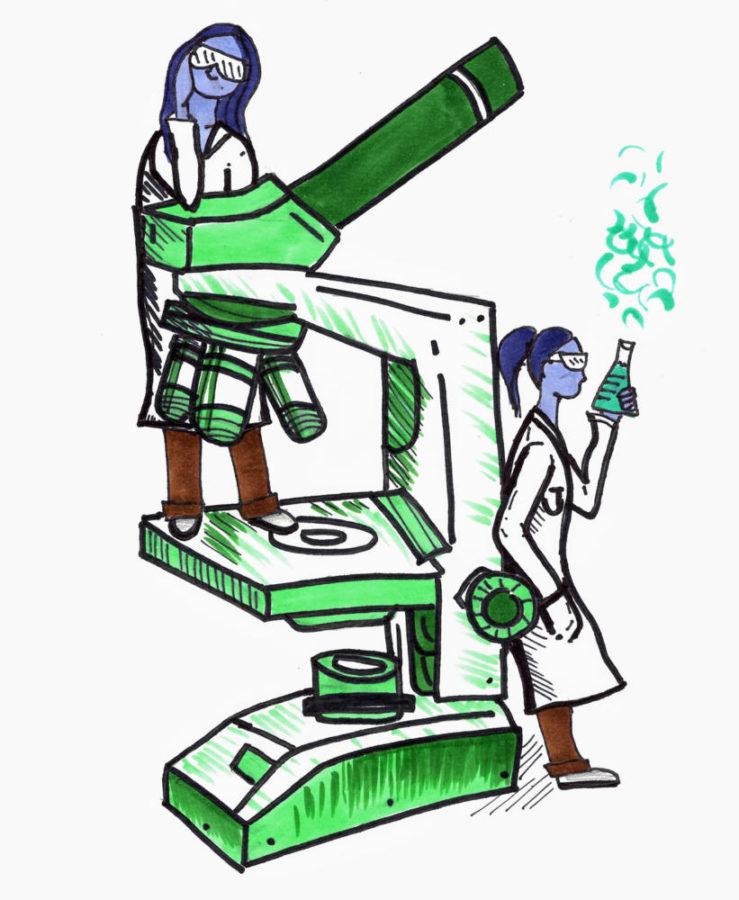Women in STEM initiatives push flawed focus
March 28, 2018
As a female actuarial mathematics student, I don’t need anyone to tell me that my gender puts me in the minority in my academic field. That’s why I’m never surprised when feminist activists point out the gender gap in STEM — what really loses me is how they tell me I should feel about it.
Universities across the country seem determined to jump on the bandwagon — holding their own women-only networking events and Q&A sessions to combat the supposedly rampant discrimination against women in technical fields.
Eager to take advantage of the special opportunities afforded to me as a woman, I decided to attend two women in STEM events right here in Pittsburgh.
The first one — sponsored by Pitt’s chapter of Society of Women Engineers last month — allowed attendees to spend six hours listening to keynote speakers, socializing with peers and networking with established employees in engineering-oriented firms. Among the speakers at this event was Barbara Staniscia, whose “pyramid for success” detailed a simple recipe for greatness in STEM fields. The formula included poise, passion and a technical foundation, a formula not only for women, but for any prospective STEM student.
And Robert Morris University’s “Empowering Women in Actuarial Science” event on March 16 featured a panel discussion between four female actuaries — Allison Young from Erie Insurance, Tove Stigum from Highmark, Lara Will from New York Life and Diane Keller, who works for Principal.
Both initiatives had good intentions — promoting STEM fields to a women where men outnumber them four to one. But they unfortunately misdiagnosed the reasons women remain underrepresented in science, and put forward solutions to the problems that miss the mark for women who actually choose to go into STEM.
Many involved in organizing events like these suggest we need women in STEM initiatives to make up for the constant discrimination they face in technical fields. These ideas seem to be conventional wisdom, but no panelist at RMU pointed to examples where they faced explicit sexism in their career.
“I’ve been very fortunate to have male colleagues who almost always respect and support me,” Stigum said.
If discrimination truly was a huge barrier to women trying to enter STEM fields, surely most panelists would have grueling stories about their victimization at the hands of a patriarchal industry — but the gender gap in STEM being attributed to discrimination is a complete distortion.
A 2016 study from the University of Glasgow that examined Scandinavia, the most progressive region in the world, suggested women’s lack of interest is to blame for the gender gap in STEM — not lack of opportunities. This leaves STEM fields much more male-dominated in well-developed countries than in countries like Algeria and Indonesia, where nearly half of all engineers are women.
Clearly, women in STEM initiatives aim to remedy a problem that can’t easily be solved. Universities and corporations should aim to acquire talented individuals in the most effective and efficient ways possible, and these programs fail to do that.
But even though women don’t struggle as much with discrimination in college or in entry-level STEM positions as some may claim, they do face challenges in the workforce when trying to navigate a mostly male environment.
Men and women engage with the corporate world differently. Women are more likely to take time off work to raise children, and when they come back they can have a hard time readjusting to working life — especially in STEM fields where technological advancement renders many learned skills obsolete in a matter of months.
“As a woman, it’s harder to find a good work-life balance,” Young said. “The same time I got promoted, I was pregnant with my first child.”
Because women make up only a quarter of STEM employees, human resources departments often don’t address these issues, instead leaving women to fend for themselves when dealing with maternity leave or reintegrating themselves into the work environment. Women in science careers also regularly report lower levels of social satisfaction on the job. This is no surprise given that most people predominantly make friends with other members of their own gender.
Women in STEM programs shouldn’t put a myopic focus on recruiting candidates who likely won’t join the STEM workforce. Instead, they should aim to support women who currently work in technical fields — many of whom have trouble fitting in with their testosterone-infused environment.
If feminists actually care about helping women in STEM careers they should stop holding these fruitless diversity initiatives for college-age girls and support women who are struggling in the workforce.
For the many women who have the talent to succeed in the intense, grueling environment that inevitably greets every STEM student, they must not be sucked into the destructive victim mentality that defines so much of the feminist women in STEM movement. Instead, they should heed the example of so many of their successful predecessors — among them, Staniscia.
“Stop being victim[s], and charge ahead with perseverance and patience,” Staniscia said.
Neena primarily writes about politics and local issues for The Pitt News. Write to Neena at nnh7@pitt.edu.



